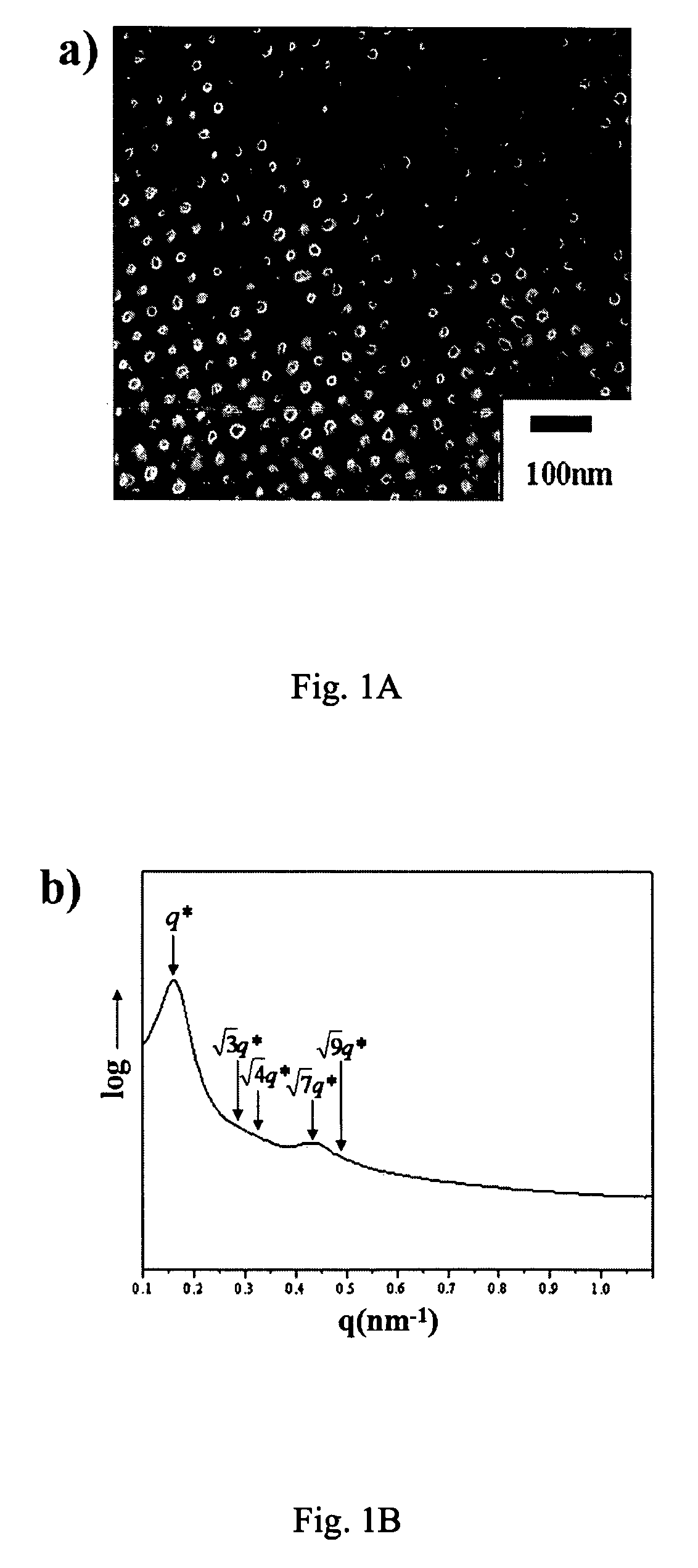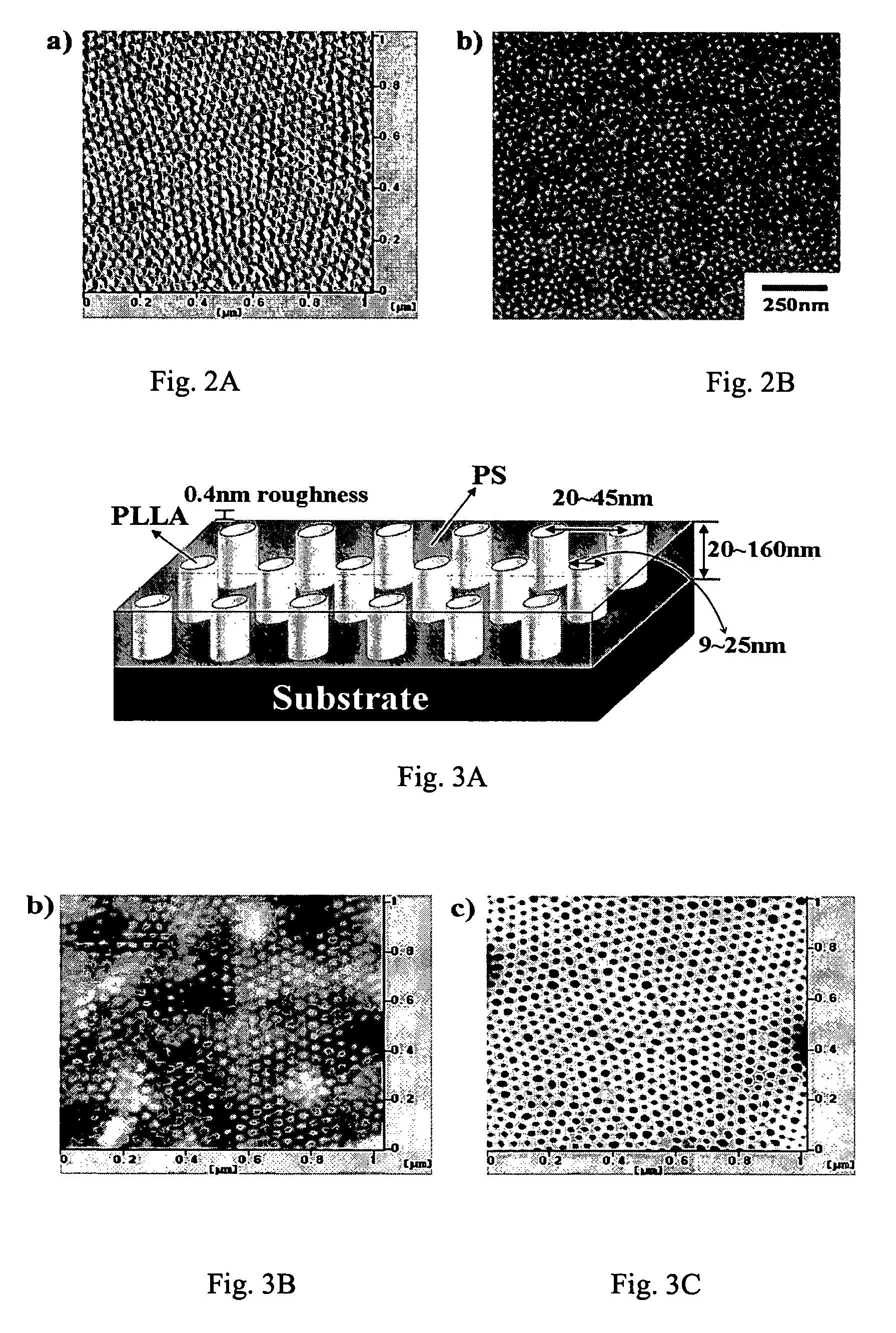Nanopatterned templates from oriented degradable diblock copolymer thin films
a copolymer and thin film technology, applied in the direction of instruments, transportation and packaging, synthetic resin layered products, etc., can solve the problems of oriented nanostructures losing orientation, and achieve the effects of extending the applicability of nanopatterns, reducing substrate influence, and efficient and cost-effectively
- Summary
- Abstract
- Description
- Claims
- Application Information
AI Technical Summary
Benefits of technology
Problems solved by technology
Method used
Image
Examples
example 1
Synthesis of 4-Hydroxy-TEMPO-Terminated Polystyrene (PS-2)
[0027]A mixture of styrene (46 mL, 400 mmol), BPO (0.39 g, 1.6 mmol) and 4-OH-TEMPO (0.33 g, 1.92 mmol) (molar ratio of 4-OH-TEMPO / BPO =1.2) was preheated in a round-bottom flask (250 mL) in nitrogen atmosphere at 95° C. for 3 h to allow BPO to decompose completely. The system was then heated at 130° C. for another 4 h to yield PS-TEMPO-4-OH. The resulting polystyrene was precipitated with methanol (300 mL) from a THF (50 mL) solution.
[0028]The product was then recrystallized twice from CH2Cl2 (40 mL) / MeOH (200 mL) mixed solution, and collected by vacuum filtration to give white solids. The final solid was washed by 100 mL MeOH and dried in vacuo overnight to form PS-2 [yield: 32.6 g (78%). Mn=20900 and PDI=1.17. 1H NMR (CDCl3): 6.46-7.09 (br, 5H, ArH), 1.84 (br, 1H, CH), 1.42 (br, 2H, CH2)]. All manipulations were carried out under a dry nitrogen atmosphere. Solvents, benzoyl peroxide, styrene, L-lactide, and deuterated solv...
example 2
Synthesis of Block Copolymers of Polystyrene-Poly(L-Lactide) (PS-b-PLA, or CP-4)
[0029]A typical ring-opening polymerization procedure was exemplified by the synthesis of CP-4. [(η3-EDBP)Li2]2[(η3-nBu)Li(0.5Et2O)]2 (0.11 g, 0.1 mmol) was added to 4-hydroxy-TEMPO-polystyrene (PS-2, 4.18 g, 0.2 mmol) in 20 mL of toluene at 0° C. The mixture was stirred at room temperature for 2 h, and then dried under vacuum. The resulting product (lithium alkoxide macroinitiator) was dissolved in CH2Cl2 (20 mL) and L-lactide (2.16 g, 15 mmol) in CH2Cl2 (10 mL) was added. While the mixture was stirred for 4 h, conversion yield (74%) of poly(L-lactide) was analyzed by 1H NMR spectroscopic studies.
[0030]The mixture was then quenched by the addition of an aqueous acetic acid solution (0.35 N, 20 mL) and the polymer was precipitated on pouring into n-hexane (300 mL) to give white solids. The product was purified by precipitation from CH2Cl2 (30 mL) / Hexane (150 mL) mixture solution. The final crystalline so...
example 3
Synthesis of Block Copolymers of PS280PLLA127
[0032]Another series of PS-PLLA copolymers with different volume ratios were prepared by the same two-step “living” polymerization sequence. On the basis of molecular weight and volume ratio, these PS-PLLAs were designated as PSx-PLLAy (ƒPLLAν=z), with x and y representing the numbers of the repeating unit for PS and PLLA blocks and z representing the volume fraction of PLLA (calculated by assuming that densities of PS and PLLA were 1.02 and 1.18 g / cm3, respectively). Bulk samples of the block copolymers were prepared by solution casting from dichloromethane (CH2Cl2) solution (10 wt % of PS-PLLA) at room temperature.
PUM
| Property | Measurement | Unit |
|---|---|---|
| vapor pressure | aaaaa | aaaaa |
| thickness | aaaaa | aaaaa |
| thickness | aaaaa | aaaaa |
Abstract
Description
Claims
Application Information
 Login to View More
Login to View More - R&D
- Intellectual Property
- Life Sciences
- Materials
- Tech Scout
- Unparalleled Data Quality
- Higher Quality Content
- 60% Fewer Hallucinations
Browse by: Latest US Patents, China's latest patents, Technical Efficacy Thesaurus, Application Domain, Technology Topic, Popular Technical Reports.
© 2025 PatSnap. All rights reserved.Legal|Privacy policy|Modern Slavery Act Transparency Statement|Sitemap|About US| Contact US: help@patsnap.com



